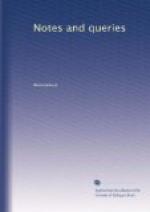“I am, til God me better
minde sende,
At Dulcarnon, right
at my witt’is ende.
Quod Pandarus
ye nece, wol ye here,
Dulcarnon clepid is
fleming[3] of wretches.”
This passage of Trolius and Creseide is quoted in the life of Sir Thomas More, given in Wordsworth’s Ecclesiastical Biography. More’s daughter said to him, when he was in prison, “Father, I can no further goe; I am come, as Chaucer said of Cressid Dulcarnon, to my witt’s end.”
Has this passage been satisfactorily explained since Tyrwhitt’s time? The epithet “Dulcarnon” is mentioned in a note to the translation of Richard de Bury’s Philobiblon, London, 1832. I give the note in full. It is in reference to the word “Ellefuga":—
“This word was a pons asinorum to some good Grecians,—but that is probably its meaning[4]; at least making it the name of a problem gets over all difficulty. The allusion is to the flight of Helle, who turned giddy in taking a flying leap, mounted on a ram, and fell into the sea;—so weak a head fails in crossing the pons. The problem was invented by Pythagoras, ’and it hath been called by barbarous writers of the latter time Dulcarnon,’—Billingsley. This name may have been invented after our author’s time. Query [Greek: dolkarenon].”
If we take the words “Dulcarnon” in this sense, it will help to explain the passage in the Troilus and Creseide.
E.M.B.
Bishop Barnaby.—The origin of the term “Bishop Barnaby,” as applied to the Lady-bird, is still unexplained.
I wish to observe, as having some possible connexion with the subject, that the word “Barnaby” in the seventeenth century appears to have had a particular political signification.
For instance, I send you a pamphlet (which you are welcome to, if you will accept of it) called “The Head of Nile, or the Turnings and Windings of the Factious since Sixty, in a dialogue between Whigg and Barnaby,” London, 1681. In this dialog, Whigg, as might be expected, is the exponent of all manner of abominable opinions, whilst Barnaby is represented as the supporter of orthodoxy.
Again, in the same year was published Durfey’s comedy, “Sir Barnaby Whigg,” the union of the two names indicating that the knight’s opinions were entirely regulated by his interest.
Q.D.
P.S. The pamphlet above alluded to affords another instance of the use of the word “Factotum,” at page 41.: “before the Pope had a great house there, and became Dominus Factotum, Dominus Deus noster Papu.”
Barnacles.—In Speculum Mundi, or a Glass representing the Face of the World, by John Swan, M.A., 4th edit., 1670, is the following mention of the Barnacle goose (pp. 243, 244.):—




